Rivane Neuenschwander: Poetics and responsability in all worldly things
If there were a quality that might apply to Rivane Neuenschwander’s unclassifiable art, it would be its capacity to implicate. A cyclic poetics of interaction animates the extremely broad range of works that eliminate the conventions of time and space, as well as the network of preconceptions based on which we build for ourselves a place in the world, often separated from one another by pre-established categories. When these sorts of mental sets for the representation of the world, or of recurring patterns that filter the experiences of our senses are destabilized, an unexpected manner of closeness may emerge.

Neuenschwander implicates us to such an extent and in such a way with manifestations of otherness − whether in the traces left by water, clouds or mollusks, or in the leftovers after certain festivities, or even in the irruption of the first love or the matter of desire − that she transcends the boundaries separating nature and culture (or also “the raw and the cooked”), artist and spectator (production and consumption), intimacy and community, educated and popular, anonymous and authorial, ultimately to create an experience of immersion in the human condition. A human condition that is vulnerable, fragile, wounded by time, subject to extinction, but saved in the end precisely through the capacity of an art like Neuenschwander‘s to open pathways towards interchange with the others, and to finding in them the reflection of our face, under a different light.
In the installation O Trabalho dos días, Days’ Work, 1998, a piece that brings to mind Hesiod’s Works and Days − and shares his observation of calendars, that way of classifying the organization of time and of agrarian labor − Neuenschwander covers the floor and walls of two rooms with materials such as hair, small pieces of leftover bread, and dust gathered onto squares of adhesive tape. In the catalogue accompanying her exhibition A Day like Any Other, organized by the New Museum, New York, in collaboration with the Irish Museum of Modern Art, Dublin, Yasmil Raymond points out that dust is “a material metaphor for the body’s transient relationship in space and time.” This dust was gathered together over the course of weeks of cleaning houses, in an allusion to domestic housework. But, undoubtedly, it is also that to which we will return, the sentence that the poet Nezahualcóyotl sang about: “Not here for too long.” The artist thus points to the impermanence and the fragility that filter into the everyday, but also to the ways of poetic persistence of the beautiful, reconstructed on the basis of discarded objects. She declares she is interested in talking about those things to which we assign no value, or consider annoying, or leave aside.
Continent/Cloud (2007) consists of Styrofoam balls moving over a translucent ceiling, activated by circulated air, and creating abstract forms in constant transformation. They allude both to the movement of the continents, whose land masses continue to modify their shape over the millennia, and to the incessant movement of the clouds, whose shapes change in a matter of seconds. This piece − acquired by the Inhotim Institute in Brazil − is installed in an old farmhouse that Neuenschwander restored specifically to this end, in such a way that its axes − the transformation of the space and the movement of time (the changing map of the heavens or of the Earth, subject to the action of its passage), give shape to a cosmogony that can be contained by the ceiling of a domestic place, referred at the same time, to the Self, in Jungian terms. Her works constantly link the macro and micro that cross the body of the human creature.
Also, Neuenschwander may submit the maps − the insinuated continents − to the action of snails or to the work of water. Carta Faminta (Starving Letter) 2001, originated in the incidental way in which the snails she kept as pets devoured sheets of rice paper that she kept in a box. Like the Colombian artist María Fernanda Cardoso, she had not only maintained a close relationship of coexistence, observation and exchange with several creatures from the animal kingdom, but in certain pieces the creatures display behaviors − the equivalent of performances − or produce formal aspects. The work in question consists of 14 maps derived from the intervention of the snails, which create unknown territories on the paper. As in all cases, the shape of the piece is subsumed into relational space, which is present from the origin of the piece to the perceptual exchange it potentiates: it extends the action and the random displacements of the snails in their breeding ground to the human imaginaries in which unknown forms tend to be inscribed within configurations that are familiar to us. In Continent/Walking in Circles, 2001, it is the microscopic trace of the spectators’ footsteps on rings of stamped adhesive that leaves the residue she considers the subject of reactivation of cycles in which art and life rotate incessantly.
In Quarta-feira de cinzas (Ash Wednesday), created in collaboration with Guimarães, she has captured the remains of the last day of Carnival in Brazil through the parade of ants carrying multicolored confetti to the beat of samba rhythms and street noises, or rhythms assembled from match boxes used as improvised percussion instruments. The association between the ephemeral and powerful nature of Carnival and the parade of a species carrying its residues evokes Levi-Strauss’s reflections in his Structural Anthropology, regarding the way in which, “…by assuming the right to radically separate humanity from animality, by giving to one everything taken from the other, Western man initiated a vicious cycle. The same frontier, constantly pushed back, has served to alienate men from other men and to claim for the benefit of increasingly restrained minorities the privilege of a humanism corrupted from the moment of its birth for having based its principle and notion on pride.” Lévi-Strauss. Structural Anthropology.”Myth. Society. Humanities.” S.XXI. Mexico: 1981. P.42
For this reason, the immaterial area of her work that is built upon involvement relationships offers possibilities for inexhaustible change. I Wish Your Wish, 2003, is inspired by a popular religious ritual that takes place at Nosso Senhor do Bonfim Cathedral in Bahia, where visitors take ribbons the length of the arm of the image of Christ and tie them to their wrists and to the church gates with three knots − one for each specific wish or request. When the ribbon eventually falls off, the wish is supposed to have been granted. In Neuenschwander’s installation, visitors find ribbons of the same size but printed with the wishes that other human beings have formulated. By taking the ribbons and replacing them with a piece of paper on which they inscribe their own wish, they assume the commitment of carrying someone else’s wish. In this way a rearrangement takes place which consists in conveying the request from the cathedral to the museum in such a way that it not only becomes a collective issue but a stranger becomes responsible for someone else’s wish. Neuenschwander is not unaware of the fact that the counterpart of desire is fear, but in both cases, the secret and the intimate, placed in a predictable and common ground, broaden the space for involvement.
The artist herself takes responsibility for the ex-voto paintings performed by craftsmen, and by appropriating them − although removing the religious iconography − she restores to the museum’s space paintings of architectures connected to the human desire for the sacred, such as they were represented by the almost anonymous popular aesthetics. The installations featuring her involuntary sculptures, based on the gathering of objects created spontaneously in different bars in Brazil while people talk, opens in the vast tradition of the readymade a ludic-affective window onto the conversation of beings whose faces we shall never see, but who leave us with a sort of residue of an intimate moment.
In First Love, a draftsman who makes portraits of the kind that police sketch artists produce sits with the spectators to recreate the faces of their first love on the basis of their narrations and descriptions. This passage from criminology to the imaginary of love, or from intimate memory to collective iconography illustrates the way in which Neuenschwander carries practices from one frontier to the other in order to develop new paradigms that suspend the patterns of experience of the known world.
In the installation Rain Rains, 2002, water leaks through tiny holes from a series of buckets suspended from the ceiling and collects in another set of buckets resting on the floor, forming a soft rainfall which must be cyclic and incessant, but which requires the intervention of the museum assistants to empty the water collected in the floor buckets back into the hanging buckets so that the rainfall cycle may start anew.
Assigning responsibility for her work to insects, or making each spectator responsible for another spectator’s wish, which he or she takes and at the same time replaces with his or her own, or charging the art institution with regulating the mechanism that keeps the work functioning, are modes of extending the network of implications in such a way that these kinds of displacements end up by patching the weave of the human.
-
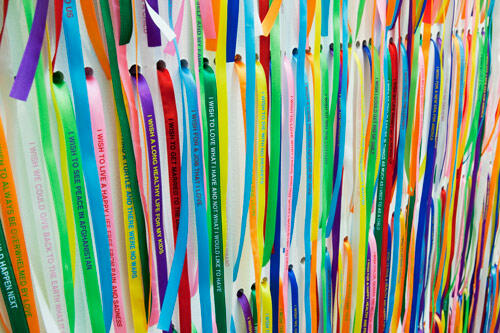 Eu desejo o seu desejo/ I Wish Your Wish / Yo deseo su deseo, 2003. Serigraph on ribbons. Dimensions variable. Thyssen-Bornemisza Art Contemporary
Eu desejo o seu desejo/ I Wish Your Wish / Yo deseo su deseo, 2003. Serigraph on ribbons. Dimensions variable. Thyssen-Bornemisza Art Contemporary
Juan and Pat Vergez Collection.
Serigrafía sobre cintas. Dimensiones variables.Thyssen-Bornemisza Arte Contemporáneo. Colección Juan y Pat Vergez. -
 As mil e una noites possiveis/ A thousand and one possible nights/Mil y una noches posibles
As mil e una noites possiveis/ A thousand and one possible nights/Mil y una noches posibles
Collage on paper (detail), in three parts, 21 1/8 x 16 in. each. Collage sobre papel (detalle). Tres partes, 53,6 x 40,6 cm cada una
Part 1: Courtesy/cortesía: the artist and Stephen Friedman Gallery, London.
Part 2: Courtesy/cortesía: the artist and Fortes & Vilaça Gallery, Sao Paulo.
Part 3: Collection of the University of Chicago, Booth Business School
-
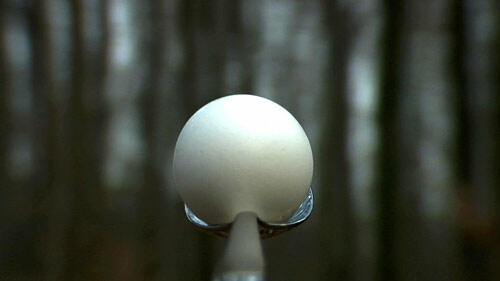 A queda/The Fall/La caída, 2009.
A queda/The Fall/La caída, 2009.
HD digital video, 0:14:30 looped. In collaboration with Sérgio Neuenschwander. Sound track: Sérgio Neuenschwander. Video digital en alta definición, 0:14:30. En colaboración con Sérgio Neuenschwander. Banda sonora: Sérgio Neuenschwander
Courtesy/cortesía:the artist, Tanya Bonakdar Galley, New York; Fortes Vilaça Gallery, Sao Paulo, and Stephen Friedman Gallery, London.
-
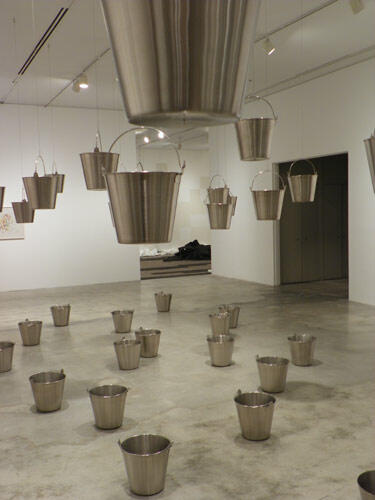 Chove chuva/ Rain Rains / Lluvia llueve. 2002. Aluminum buckets, water, steel wire, ladder. Dimensions variable. Private Collection.
Chove chuva/ Rain Rains / Lluvia llueve. 2002. Aluminum buckets, water, steel wire, ladder. Dimensions variable. Private Collection.
Photo credit and courtesy: Willy Castellanos
Baldes de aluminio, agua, cable de acero, escalera. Dimensiones variables. Colección privada. Crédito y Cortesía: Willy Castellanos
-
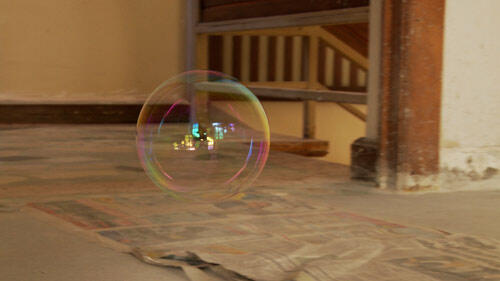 O Inquilino/ The Tenant/ El Inquilino, 2010. HD digital video, 0:10:34. In collaboration with Cao Guimarães. Sound track: O Grivo
O Inquilino/ The Tenant/ El Inquilino, 2010. HD digital video, 0:10:34. In collaboration with Cao Guimarães. Sound track: O Grivo
Courtesy of the artist, Tanya Bonakdar Gallery, New York; Fortes & Vilaça Gallery, Sao Paulo; and Stephen Friedman Gallery, London.
Video digital en alta definición, 0:10:34. En colaboración con Cao Guimarães. Banda sonora: O Grivo
Cortesía de la artista, Galería Tanya Bonakdar, Nueva York; Galería Fortes & Vilaça, San Pablo, y Galería Stephen Friedman, Londres
-
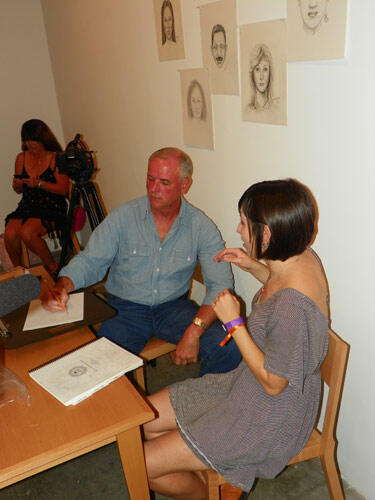 Primeiro amor/First Love/Primer amor, 2005. Drawing on paper, police artist’s sketch, table and chairs, 11 3/8 x 8 ¼ each. Photo: Willy Castellanos
Primeiro amor/First Love/Primer amor, 2005. Drawing on paper, police artist’s sketch, table and chairs, 11 3/8 x 8 ¼ each. Photo: Willy Castellanos
Courtesy of the artist, Tanya Bonakdar Gallery, New York; Fortes & Vilaça Gallery, Sao Paulo; and Stephen Friedman Gallery, London.
Dibujo sobre papel, retrato hablado a la policía, mesa y sillas. 29 x 21 cm cada uno. Foto: Willy Castellanos. Cortesía de la artista, Galería Tanya Bonakdar, Nueva York; Galería Fortes & Vilaça, San Pablo, y Galería Stephen Friedman, Londres




